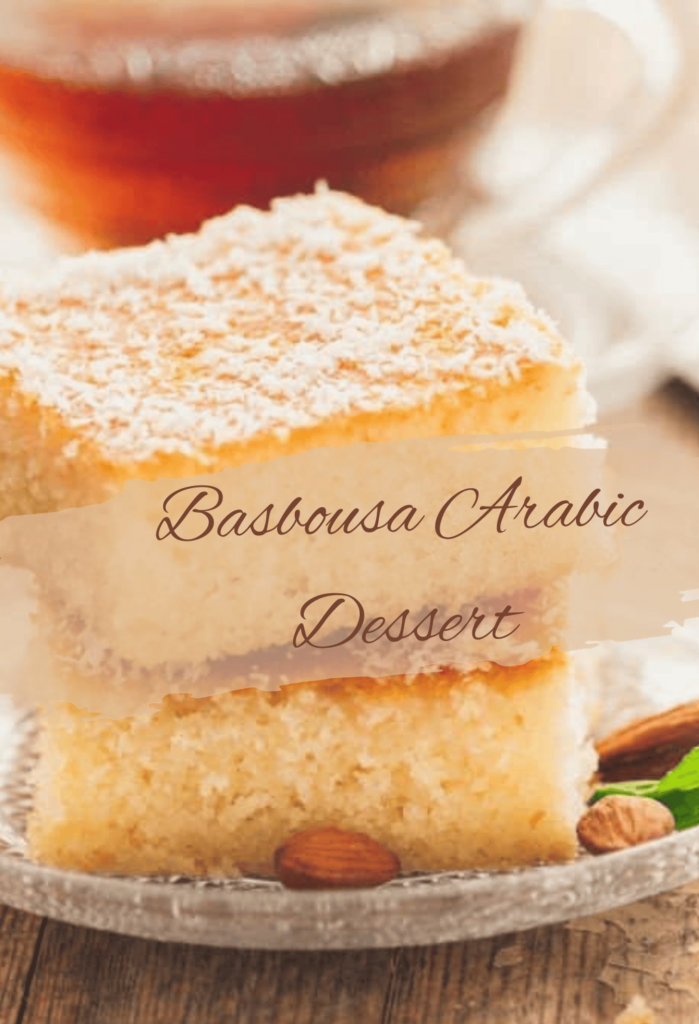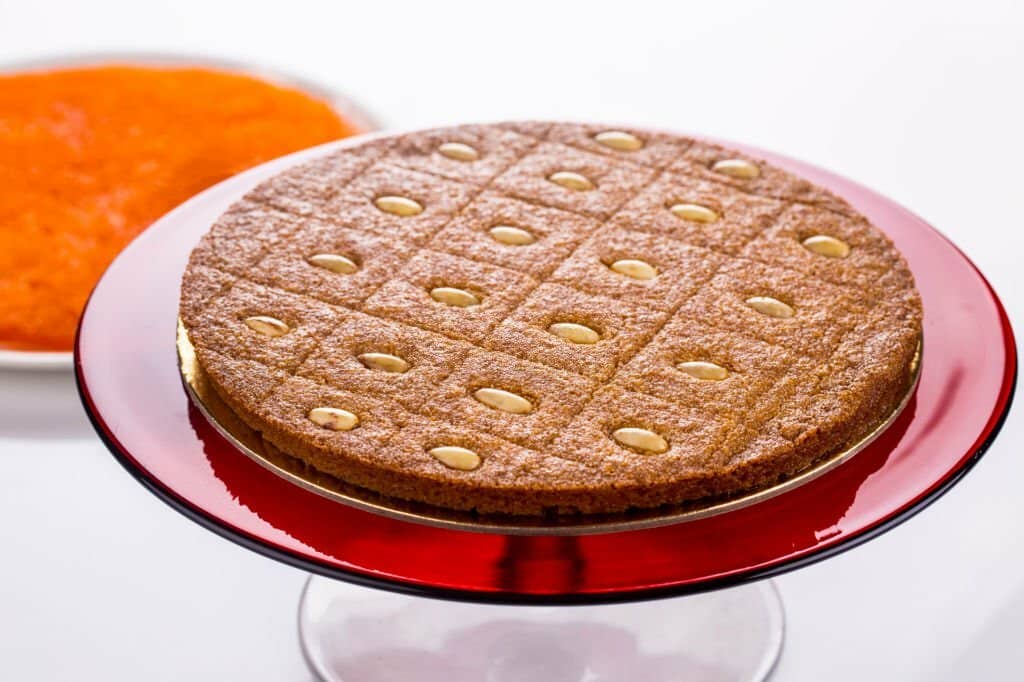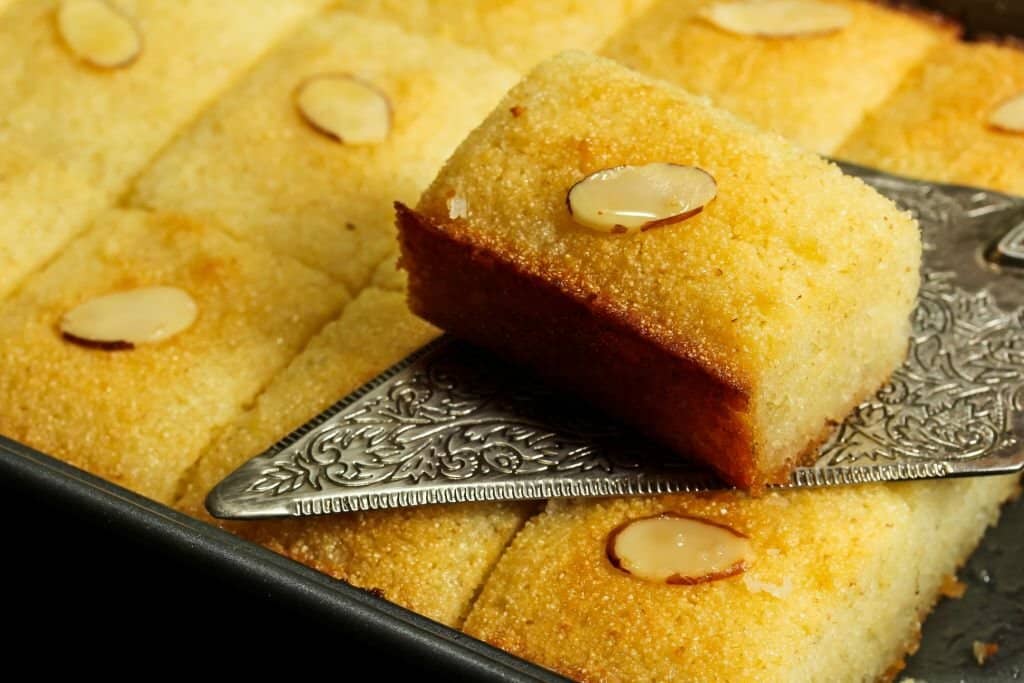Basbousa is an Egyptian dessert that is popular in many countries of the Middle East, North Africa, and Greece. It is typically made of semolina, coconut, yogurt, syrup, and ghee.
Basbousa is widely famous throughout the Middle East. It is often enjoyed at festivals, holidays, and weddings. Basbous in the Middle East is a very common dessert, you can find them in streets, bakeries, and restaurants and it is often enjoyed as a snack with tea or coffee.
What is Basbousa Dessert

Basbousa is an Egyptian dessert that is popular throughout the Middle East, North Africa, Egypt, and Turkey. It is a semolina cake made by baking semolina batter and soaked in flavor syrup like rose water and orange flavor water. In different regions, it is known by various names such as Hareeseh, Revani, or Ravani.
Basbousa is an easy-to-make recipe with a delicious aromatic flavor. It is a common dessert in Egypt, Turkey, Greece, and other Middle East countries. Basbousa is a crowd-pleasing dessert as it takes little effort but gives a unique and delicious taste.
People always love to have Basbousa but it is very common to indulge during Ramadan or the Christian festival.
Basbousa Origin
Basbousa origin goes back to the “revani” of Turkish cuisine. During the Ottoman Empire revani was made by a pastry chef in the 16th century to celebrate the conquest of Armenia with the city of Revan which is now known as Yerevan.
Over time, revani became a popular dessert in Ottoman cuisine and its name evolved. Another possible source for the name “Revani” is a poet named Revani who lived in Turkey during the 15th and 16th centuries.
The history of Basbousa is closely connected to the Ottoman Empire, where it transformed from revani into a beloved dessert, leaving a lasting impact on the world of sweets. The name Basbousa comes from the Arabic word “bas,” which means blend as Basbousa is made by mixing semolina flour.
It might have different names in various places, like “hareesa” in the Levant. Don’t confuse it with the spicy red sauce called “harissa” in North Africa. People enjoy eating Basbousa, and it’s a favorite dessert during the holy month of Ramadan.
What is Basbousa Cake Made of?

Basbousa is made from semolina which is coarse wheat flour. Other key ingredients in Basbousa cake typically include sugar, yogurt, and desiccated coconut. It’s also flavored with rosewater or orange blossom water, and it’s often garnished with blanched almonds or pistachios.
After baking, the cake is soaked in a sweet syrup, usually made with sugar, water, lemon juice, or rosewater which gives it its characteristic sweet and moist texture.
Basbousa is known for its unique, slightly grainy texture and sweet, fragrant flavor. It’s a delightful dessert enjoyed in many Middle Eastern and Mediterranean countries.
Typically Basousa is baked in the tray and cut into diamond pieces and often served in the same tray.
Basbousa Does Basbousa Taste Like
Basbousa offers a unique and delightful taste characterized by its sweet, slightly grainy texture from semolina. It is moist from the inside and crispy from the outside which makes it a perfect balance of flavor and texture.
Due to flavor syrup such as rose water or orange flavor water, it has an aromatic touch. After baking, It is topped with nuts like pistachio, walnuts, and Hazelnuts.
We can say that the taste of Basbousa is a perfect balance of sweetness, crunchiness, textures, and flavors. It has all that is loved by any dessert lover.
Basbousa Recipe
Basbousa is very easy to make with just a few available ingredients:
Ingredients:
For the cake:
- 1 cup semolina
- 1 cup plain yogurt
- 1 cup granulated sugar
- 1 cup desiccated coconut
- 1/2 cup unsalted butter, melted
- 1 teaspoon baking powder
- 1/4 cup all-purpose flour
- 1 teaspoon vanilla extract
- 1/4 cup milk (if needed)
For the sugar syrup:
- 1 cup granulated sugar
- 1/2 cup water
- 1 teaspoon lemon juice
- 1 teaspoon rose water or orange blossom water (optional)
For garnish:
- Slivered almonds or chopped pistachios
Instructions:
- Preheat your oven to 350°F (180°C). Grease a baking dish (8×8 inches or a similar size) and set aside.
- In a large mixing bowl, combine semolina, yogurt, sugar, desiccated coconut, melted butter, baking powder, and vanilla extract. Mix well until all the ingredients are well combined. If the batter is too thick, you can add a little milk to achieve a smooth consistency.
- Pour the batter into the greased baking dish and smooth the top with a spatula.
- Using a knife, score the surface of the batter into diamond or square shapes. This will help the sugar syrup penetrate the cake later.
- Bake in the preheated oven for 30-40 minutes or until the top is golden brown and a toothpick inserted into the center comes out clean.
- While the cake is baking, prepare the sugar syrup. In a saucepan, combine sugar, water, and lemon juice. Bring the mixture to a boil, then reduce the heat and simmer for about 10-15 minutes until it thickens slightly. Add rose water or orange blossom water if desired. Allow the syrup to cool.
- Once the cake is done baking, remove it from the oven and immediately pour the cooled sugar syrup over the hot cake. Make sure to evenly distribute the syrup over the entire surface.
- Allow the basbousa to absorb the syrup and cool for a few hours before cutting it into squares or diamonds along the pre-scored lines.
- Garnish with slivered almonds or chopped pistachios before serving.
What are the Other Names of Basbousa

In different regions, Basbousa is known by different names. It is known as Basbous in many Middle Eastern countries
It also harissa or harissa hloua in Tunisia and in the Egyptian city of Alexandria, kalb el louz in Algeria, chamia in Morocco, revani or rabani in Turkey, safra in Israel, pastūsha in Kuwait, namoura in Lebanon or Syria, revani in Greece, shammali in Cyprus, or shamali in Armenia.
Despite being known by different names, Its preparation and taste are almost the same in countries.
Babousa Variation
There are many varieties of Basbousa available in different countries. Here we mentioned some of them.
Pastusha
This variant of Basbousa originated in Kuwait in the 2010s. Like traditional Basbousa, it is made of semolina soaked in sweet syrup.
But unlike Babousa, pastūsha contains finely ground pistachios and orange flower water which make it a unique flavor and texture.
Basbousa bil ashta
This variation hails from the Levant region. It is filled with ashta cream in the middle which offers a creamy contrast to the semolina base’s sweetness. The combination of the rich cream and sweet syrup is a delectable treat.
Vegan Basbousa
For those who follow a vegan diet, there’s a vegan version of Basbousa. Instead of using dairy and eggs, it is made by using apple sauce.
Basbousa eem Tapuzim
This is an Israeli variation of Basbousa. It is made by using orange juice in the preparation. The addition of orange juice gives a sweeter and more aromatic flavor to the dessert and makes it a refreshing twist on the classic.
Basbousa bil Tamr
A Libyan variant of Basbousa, this version includes a date spread between two layers of the semolina cake. The dates infuse the dessert with a natural sweetness and a unique depth of flavor.
Basbousa eem Tmarim
Another Israeli variant with dates, this version is distinct from the Libyan variant. In this variation, the dates are cooked in ghee and they are complemented by the addition of cinnamon and cardamom which gives a rich, aromatic, and darker color. It is often served with tea after the fasting of Yom Kippur.
Qizha
This is a Palestinian variant of Basbousa that is made with a paste of nigella seeds also called Qizha. The addition of Qizha provides a unique and slightly bitter flavor.
Hilbeh
Another Palestinian variation is hilbeh-flavored Basbousa is made using fenugreek seeds. Fenugreek seeds have a slightly bitter taste and are known for their aromatic qualities.
Related Post: Is Baklava Greek Or Turkish
Summary
Basbousa is a yummy dessert enjoyed in many places in the Middle East, North Africa, and Greece. It’s a sweet treat with a slightly grainy texture and aromatic taste. People in different regions have their versions of making Basbousa and each with its own name and unique twists.
Whether you like the traditional recipe or want to try something special Basbousa is great for celebrations, holidays, or as a snack with tea or coffee. It’s a fantastic treat for special occasions or when you want something sweet with your tea or coffee.

